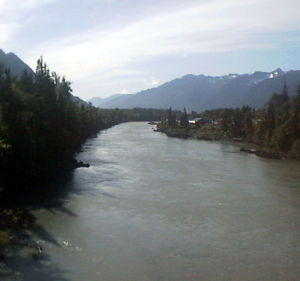- Nass River
-
Nass River River View west on Nass River at GitwinksihlkwCountry Canada Province British Columbia Source Coast Mountains Mouth Nass Bay - location Portland Inlet - coordinates 54°58′37″N 129°53′22″W / 54.97694°N 129.88944°W [1] Length 380 km (236 mi) [2] Basin 20,839 km2 (8,046 sq mi) [3] Discharge mouth - average 770 m3/s (27,192 cu ft/s) [4] The Nass River is a river in northern British Columbia, Canada. It flows 380 km (240 mi) from the Coast Mountains southwest to Nass Bay, a sidewater of Portland Inlet, which connects to the North Pacific Ocean via the Dixon Entrance. Nass Bay joins Portland Inlet just south of Observatory Inlet.[5][6]
The English name "Nass" is derived from the Tlingit name Naas which means "intestines" or "guts" in reference to the river's large food capacity in its fish (Naish & Story 1963; Leer, Hitch, & Ritter 2001). The Nisga'a name for the river is K'alii Aksim Lisims "Lisims (river name) Valley". The Gitxsan name is Git-Txaemsim meaning People of Txeemsim (Raven or Trickster).[1]
The last 40 km (25 mi) of the river are navigable. The river is a commercially-valuable salmon fishery. The basin of the Nass is the location of the first modern-day treaty settlement in British Columbia, between the government of that province and the Nisga'a Nation. Nisga'a is a derivative of two Nisga'a words - Nisk' (top lip) & Tl'ak' (bottom lip) so called because the Nass River is so bountiful in food, many nations & creatures come to the river to eat.
Contents
History
About 220 years ago, according to legend of the Nisga'a people, the Nass River was dammed by a 22.5 km long lava flow which came from the Tseax Cone and destroyed the Nisga'a villages and caused the death of at least 2000 Nisga'a people by volcanic gas and poisonous smoke. The volcano has been active on at least two occasions (220 and 650 years ago) in the last millennium. Because of our knowledge of this previous disaster, modern monitoring techniques should include studies of the gases emitted by the volcanoes and the institution of a warning system to alert people living down slope from the volcanoes.
Hazards
If the Tseax Cone were to erupt again, there could be a repeat of the poisonous gas disaster that happened to the Nisga'a people 220 years ago. The eruption could also cause forest fires and could potentially dam local rivers such as the Nass River and the Tseax if the volume of the lava flows are large enough. If the lava flows were to again reach the Nass River, it could have disastrous short-term consequences for the important salmon fisheries on the Nass River system.
See also
References
- ^ a b "Nass River". BC Geographical Names. http://apps.gov.bc.ca/pub/bcgnws/names/27569.html.
- ^ Nass River, The Columbia Gazetteer of North America
- ^ Gazetteer of Canada. British Columbia. Canadian Board on Geographic Names. 1953. p. xv.
- ^ Normal Runoff from British Columbia, Ministry of Environment, Water Stewardship Division
- ^ "Bay Point". BC Geographical Names. http://apps.gov.bc.ca/pub/bcgnws/names/36089.html.
- ^ "Nass Point". BC Geographical Names. http://apps.gov.bc.ca/pub/bcgnws/names/36867.html.
Categories:- Rivers of British Columbia
- Nass Country
- Coast Mountains
Wikimedia Foundation. 2010.


